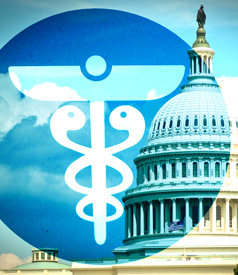Monday 29 March 2010
by: Emily Badger | Miller-McCune

(Image: Jared Rodriguez / t r u t h o u t; Adapted: takomabibelot, Josh Self)
From breast pumping to adoption tax credits, the leviathan known as the U.S. health care bill is loaded with little goodies.
The 2,000-page health care bill that became law last week is packed with major reforms probably well known (in concept if not in detail) by anyone who has channel-surfed through the nightly news over the past year. There's an individual mandate, a system of exchanges, new government subsidies and a ban on some of the worst practices of the insurance industry.
Let's say the small print on the big stuff accounts for about 1,500 pages, give or take a ream. What's in the rest? Some random, weird and interesting solutions to problems you may or may not have known you had, some with dubious connection to health care at best. As a public service, we explain some of them here.
The Idea Lobby lists these provisions without endorsement or critique (although cobbling them all together on a single page does make the aggregate look a little scatterbrained). But, rest assured, someone in the know championed hard for each one: the Center for Science in the Public Interest, National Indian Health Board, the National Consumer Voice for Quality Long-Term C
1. Menu labeling. The legislation mandates that national chains with at least 20 restaurants must post "nutrient content disclosure statements" — in other words, calorie counts right next to the menu offering "Big Mac." To drive the point home, menus will also have to mention your suggested daily caloric intake. The provision has all kinds of addendums to deal with seasonal specials, salad bars, vending machines and condiments, but the main idea is this: Maybe we'll eat less garbage if we can't remain willfully ignorant about how bad it is for us.
2. Swag disclosure. The bill contains key elements of the Physician Payments Sunshine Act, a previously bipartisan idea calling for pharmaceutical reps and device manufacturers to disclose all the goodies they give doctors. This includes money, gifts, food, travel, entertainment, grants, just about anything that may constitute a conflict of interest. The "transparency reports" must be submitted to the Secretary of Health and Human Services and will be posted on a publicly searchable Web site.
3. Right to pump. Workplaces will have to provide "reasonable" break time and a private location — other than a bathroom — for breastfeeding mothers to pump breast milk for one year after the birth of a child. Women's groups have long sought such guarantees, and this one will apply to all workplaces with the exception of employers with less than 50 employees, where the demand might create an "undue hardship."
4. Postpartum depression. In addressing another priority for women's groups, the bill singles out the problem of postpartum depression for expanded funding, worker training, publiceducation and research. The National Institute of Mental Health is due to conduct a national longitudinal study of women with postpartum depression, and the Secretary of Health and Human Services must produce a study on the benefits of PPD screening.
5. Tanning tax. Starting July 1 of this year, there will be a new 10 percent excise tax on indoor tanning services (in legislative speak, "a service employing any electronic product designed to incorporate [one] or more ultraviolet lamps and intended for the irradiation of an individual by ultraviolet radiation, with wavelengths in air between 200 and 400 nanometers, to induce skin tanning"). Something called "phototherapy" is excluded.
6. Adoption credit. Beginning with your 2010 taxes, the federal adoption credit goes up by $1,000 to $13,170 per child and now becomes refundable. As one happy advocate blogged, "I'm pretty creative in coming up with ways that adoption is good for all concerned, but even I think the connection of the adoption tax credit and health care is tenuous."
7. Indian health. The bill incorporates aspects of the Indian Health Care Improvement Act, a goal of organizations who point out American Indians have the worst health disparities of any minority group in the U.S., particularly dealing with suicide, alcoholism and tuberculosis. The law increases funding and support on tribal lands for behavioral health and substance abuse, health care worker recruitment and facilities construction.
8. Background checks. The Secretary of Health and Human Services is tasked with developing a national system for conducting criminal background checks of prospective health care workers who would deal directly with patients in long-term care facilities or private homes. This is one of a suite of changes aimed at protecting seniors in nursing homes.
9. Abstinence education. The bill restores federal funding for abstinence-only education, the sex-ed technique that urges students to wait until marriage (while eschewing talk of contraceptives). Researchers dispute the effectiveness of the strategy, and it was getting the cold shoulder from the Obama administration. The health reform bill, however, allocates $250 million for such programs over the next five years.
10. Your W-2. Changes are coming to your tax paperwork. Come next January, the W-2 you receive from your employer (if, hopefully, you have one) will include the cost of employer-provided health care you probably have not quantified before. This will become much more relevant in 2018, when people with the so-called high-cost "Cadillac" plans will have to start paying a hefty tax on it.

No comments:
Post a Comment